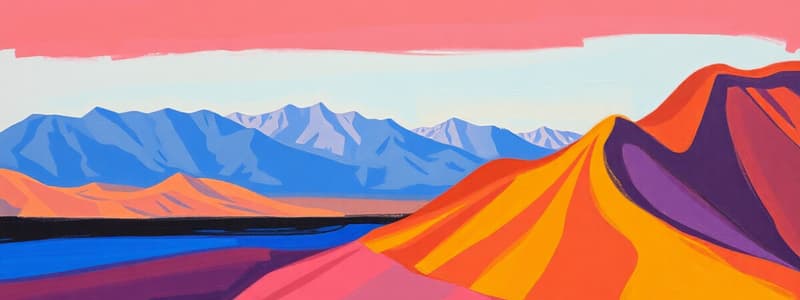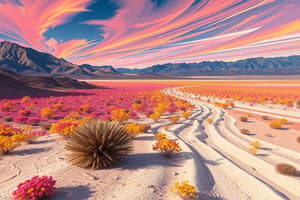Podcast
Questions and Answers
How do the Andes Mountains and the Pacific Ocean interact to influence Chile's climate and geography?
How do the Andes Mountains and the Pacific Ocean interact to influence Chile's climate and geography?
- They create a uniform climate across the country, resulting in consistent rainfall and temperatures.
- They contribute to diverse geographic regions by creating rain shadows and narrow valleys. (correct)
- They cause frequent earthquakes and volcanic activity, reshaping the landscape constantly.
- They block all moisture from entering Chile, creating a completely arid environment.
What is a distinctive characteristic of the Near North region of Chile, and how does it support agriculture?
What is a distinctive characteristic of the Near North region of Chile, and how does it support agriculture?
- Volcanic soil and geothermal activity enable the cultivation of tropical fruits.
- High winds and coastal fog create ideal conditions for wheat farming.
- Frequent flooding provides fertile soil for rice cultivation.
- Lush green valleys with irrigation systems support vineyards amidst barren desert peaks. (correct)
In what way does the geography of the Central Valley contribute to Chile's economic and demographic features?
In what way does the geography of the Central Valley contribute to Chile's economic and demographic features?
- Its frequent earthquakes and volcanic activity have discouraged permanent settlement and investment.
- Its rugged terrain and isolation have hindered population growth and economic development.
- Its arid climate and limited water resources have restricted agricultural productivity.
- Its mild climate, plentiful resources, and central location have fostered population concentration and agricultural activity. (correct)
How does the Atacama Desert's location between the Andes and the Chilean Coast mountain ranges influence its climate?
How does the Atacama Desert's location between the Andes and the Chilean Coast mountain ranges influence its climate?
What unique environmental feature in Chile's Far North supports desert blooms and waterfowl despite the regions aridity?
What unique environmental feature in Chile's Far North supports desert blooms and waterfowl despite the regions aridity?
What is a key difference between the Andes Mountains in the Near North and Central Chile?
What is a key difference between the Andes Mountains in the Near North and Central Chile?
How does the Southern Zone of Chile, also known as the Lake District, contrast with the Atacama Desert in terms of precipitation?
How does the Southern Zone of Chile, also known as the Lake District, contrast with the Atacama Desert in terms of precipitation?
What geographical occurrences characterize the Far South region of Chile?
What geographical occurrences characterize the Far South region of Chile?
What impact does the temperate climate in Central Chile have on its agricultural production?
What impact does the temperate climate in Central Chile have on its agricultural production?
Which natural phenomenon contributes to the formation of temporary oases and fertile river valleys in the Atacama Desert?
Which natural phenomenon contributes to the formation of temporary oases and fertile river valleys in the Atacama Desert?
Flashcards
Atacama Desert
Atacama Desert
A desert in Chile, one of the driest places on Earth, where some areas have never recorded rainfall.
Altiplano
Altiplano
A high plateau on the eastern side of the Atacama Desert in Chile, known for plentiful rain at certain times of the year.
Elqui Valley
Elqui Valley
Valleys in Chile's Near North region, known for vineyards flourishing due to irrigation from the Elqui River.
Southern Zone/Lake District
Southern Zone/Lake District
Signup and view all the flashcards
Araucaria Tree
Araucaria Tree
Signup and view all the flashcards
Far South
Far South
Signup and view all the flashcards
Central Valley
Central Valley
Signup and view all the flashcards
Cape Horn
Cape Horn
Signup and view all the flashcards
Study Notes
- Chile is a South American country characterized by contrasts and extreme geography.
- It is a narrow strip of land stretching approximately 2,700 miles from the Atacama Desert in the north to Tierra del Fuego's fjords and glaciers in the south.
- Chile is one of the world's longest countries, averaging 110 miles wide, with its widest point at 220 miles.
- The country is defined by the Pacific Ocean to the west and the Andes Mountains to the east, bordering Bolivia and Argentina.
- The Andes are the highest mountains outside of Asia.
- Smaller coastal mountain ranges create a central valley, contributing to diverse geographic regions.
The Far North
- The Atacama Desert, one of Earth's driest places, is in the Far North.
- Some areas have never recorded rainfall, but oases and lagoons exist, sustaining life such as desert blooms and three flamingo species.
- The Andean plateau (Altiplano) is partly responsible for this, providing water to the desert, forming oases and river valleys.
The Near North
- The Near North, south of the Atacama Desert, contains three of Chile's highest mountains.
- Coastal and Andes ranges merge, forming valleys from the Andes to the coast.
- The Elqui Valley is known for vineyards growing beside desert peaks.
- High mountains help to create temperate rain forests along the coast.
Central Chile
- Andes Mountains and coastal ranges run north to south, creating the wide Central Valley.
- It has a temperate climate similar to California and the Mediterranean, with dry summers and cool, rainy winters.
- Rich agricultural lands, a mild climate, and water access support Chile's largest cities, including Santiago.
Southern Zone
- Also known as the Lake District, it is south of the Central Valley.
- The area sits at lower elevation than the Central Valley; abundant rivers form lakes.
- The zone contrasts with the Atacama, being one of the rainiest areas with lush landscapes, ferns, wildflowers, and forests.
- Conguillío National Park is home to Araucaria trees, also known as Monkey Puzzle Trees.
The Far South
- Chile extends to Cape Horn, part of the Tierra del Fuego archipelago.
- The Andes Mountains and the Pacific and Atlantic Oceans converge, creating a cold, windy area.
- The landscape includes islands, fjords, channels, glaciers, and ice fields far beyond the Atacama Desert.
Studying That Suits You
Use AI to generate personalized quizzes and flashcards to suit your learning preferences.





